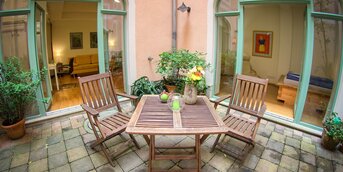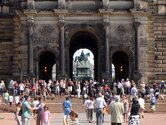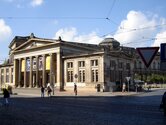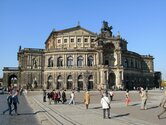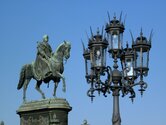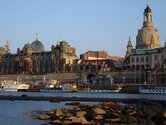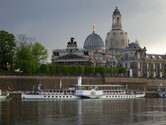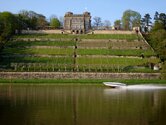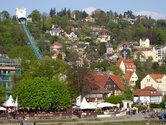Around Theaterplatz Square in Dresden
From the point of view of the history of architecture the Theaterplatz is the most important square of Dresden. It is surrounded by a rich in contrast conglomerate, composed of the architectural styles Baroque, Renaissance and Classicism – the baroque Catholic Hofkirche, Dresden Castle (Renaissance), the classical Schinkelwache of Altstadt (Old town), the baroque Zwinger Palace, the Old Masters Picture Gallery (Gemäldegalerie/Sempergalerie), the Semper Opera House (neo- Renaissance), and the Italian Village (Classicism).
The Zwinger Palace
Beginning from 1709 this world famous baroque synthesis of the arts of architecture, sculpture and painting was constructed under the direction of the architect Matthäus Daniel Pöppelmann (1662 - 1736) and the sculptor Balthasar Permoser (1651 – 1732) by order of the Saxon elector August the Strong (1670 – 1733). Started as an orangery the Zwinger Palace soon evolved into an excellent site of courtly culture of festivals and representation of August the Strong. Today the Zwinger Palace houses the royal founded art collections:
- Old Masters Picture Gallery,
- Armoury,
- Collection of Porcelain and
- Mathematisch-Physikalischer Salon.
Old Masters Picture Gallery (Gemaeldegalerie Alte Meister/Sempergalerie)
Until 1847 the side of the Zwinger Palace facing to the river Elbe was shut with just a single wall. Gottfried Semper (1803 - 1879) received the order from the Saxon courtyard to build a representative picture gallery in this area. Matching to the by him erected first Royal Theatre (burned down in 1869 and replaced by the Semper Opera House in 1878) Semper chose for the building the style of the Italian High Renaissance. Inside the building you can find the Old Masters Picture Gallery, part of the State Art Collections (Staatliche Kunstsammlungen Dresden).
Semperoper
One of the most beautiful opera houses in the world! The Dresden Ballet, the State Opera Chorus and the world famous Saxon State Orchestra have your workplace here. More information ...
King Johann Monument
From 1854 to 1873 was with King Johann of Saxony (1801 - 1873) a scholar on the throne of Saxonia. He was a linguist and a jurist by training. You can find out many things he did as a scholar on the socle of the 1889 erected monument.
Carl Maria von Weber Monument
This larger than life-sized bronze sculpture is to the honour of the famous composer Carl Maria von Weber (1786 - 1826), who worked from 1817 up to his death in 1826 as Court Music Director in Dresden. Here he composed among others the operas "Der Freischütz", "Euryanthe" und "Oberon".
Italian Village (Italienisches Doerfchen)
Between Theaterplatz Square and the bank of the river Elbe a sandstone building in the classical style of an eighteenth century park pavilion is located. It was originally part of an ensemble of several houses. Italian building workers established their domicile there when constructing the Catholic Hofkirche 1739 – 1754. In 1817 Carl Maria von Weber (1786 - 1826) found here his first Dresden dwelling – in the house of the castrato and famous sopranist Ceccarelli.
The Schinkelwache (Altstaedter Wache)
The Schinkelwache constructed between 1830 and 1832 by the Prussian master builder Karl Friedrich Schinkel (1781 - 1841) is a Classical sandstone building modelled on an Ionic Temple (also called Schinkelwache). Tympanums decorated without attracting attention give an appearance to the building, which is more cautious and gracile than Schinkel’s “Neue Wache” in Berlin (completed in 1818). Today there are in the building a restaurant and a tourist information with an advance booking office of the Dresden Theatres, also for our guests in the vacation rentals in Dresden city centre.

